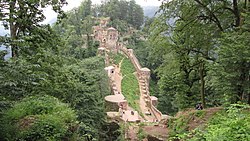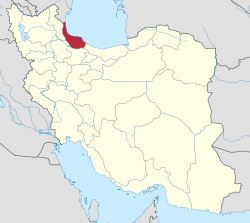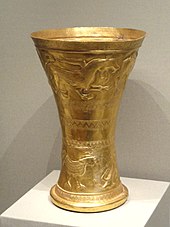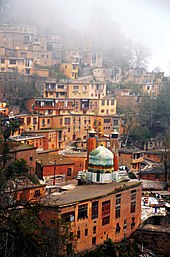Gilan province
Gilan Province
| |
|---|---|
 | |
 Location of Gilan province within Iran | |
| Coordinates:37°26′N49°33′E/ 37.433°N 49.550°E[1] | |
| Country | Iran |
| Region | Region 3 |
| Capital | Rasht |
| Counties | 17 |
| Government | |
| •Governor-general | Asadollah Abbasi |
| • MPs ofAssembly of Experts | 1Ahmad Parvaei Rik 2Reza Ramezani Gilani 3Seyed Ali Hosseini Ashkevari 4Zaynolabideen Ghorbani |
| • Representative of theSupreme Leader | Rasool Falahati |
| Area | |
| • Total | 14,042 km2(5,422 sq mi) |
| Population (2016)[2] | |
| • Total | 2,530,696 |
| • Density | 180/km2(470/sq mi) |
| Time zone | UTC+03:30(IRST) |
| Area code | 013 |
| ISO 3166 code | IR-01 |
| Main language(s) | Gilaki Talyshi |
| HDI(2017) | 0.805[3] very high·11th |
| Others(s) | Persian[4] Azeri[5][6][7][8][9][10] |
| Website | www |
Gilan province(Persian:استان گیلان)[a]is one of the 31provinces of Iran,in the northwest of the country. Its capital is the city ofRasht.[12]The province lies along theCaspian Sea,in Iran'sRegion 3,west of the province ofMazandaran,east of the province ofArdabil,and north of the provinces ofZanjanandQazvin.[13]It bordersAzerbaijan(Astara District) in the north.
The northern section of the province is part of the territory of South (Iranian)Talysh.At the center of the province isRasht.Other cities includeAstaneh-ye Ashrafiyeh,Astara,Fuman,Hashtpar,Lahijan,Langarud,Masuleh,Manjil,Rudbar,Rudsar,Shaft,Siahkal,andSowme'eh Sara.The main port isBandar-e Anzali,formerly known as Bandar-e Pahlavi.
At the time of the 2006 National Census, the province was home to 2,381,063 people in 669,221 households.[14]The following census in 2011 counted 2,480,874 in 777,316 households.[15]By the time the latest census was conducted in 2016, the population of Gilan had risen to 2,530,696 people in 851,382 households.[2]
History
[edit]Paleolithic
[edit]Early humans were present at Gilan sinceLower Paleolithic.Darband Caveis the earliest known human habitation site in Gilan province; it is located in a deep tributary canyon of theSiah Varudand contains evidence for the earliest prehistoric human cave occupation during the Lower Paleolithic in Iran.
Stone artifacts and animalfossilswere discovered by a group of Iranian archaeologists that dates back to the lateChibanian.[16]Yarshalman is aMiddle Paleolithicshelter that was probably occupied byNeanderthalsabout 40,000 to 70,000 years ago.[16]Later Paleolithic sites in Gilan areChapalak Cave[17]andKhalvashtshelter.[18]
Early history
[edit]It seems that theGelae,or Gilites, entered the region south of the Caspian coast and west of the Amardos River (now called theSefid-Rud) in the second or first century BCE,Plinyidentifies them with theCadusiiwho were living there previously. It is more likely that they were a separate people, had come from the region ofDagestan,and taken the place of the Kadusii. That the native inhabitants of Gilan have some originating roots in theCaucasusis supported by genetics and language, as the Y-DNA ofGilaksmost closely resemble that ofGeorgiansand otherSouth Caucasuspeoples, while their mtDNA closely resembles otherIraniangroups.[19]Their languages shares typologic features with thelanguages of the Caucasus.[20]
Medieval history
[edit]Gilan province was the place of origin of theZiyarid dynastyandBuyid dynastyin the mid-10th century. Previously, the people of the province had a prominent position during theSassanid dynastythrough the 7th century, so that their political power extended toMesopotamia.
The first recorded encounter between Gilak andDeylamitewarlords andinvading Muslim armieswas at theBattle of Jalulain 637 AD. Deylamite commander Muta led an army of Gils, Deylamites,Persiansand people of theReyregion. Muta was killed in the battle, and his defeated army managed to retreat in an orderly manner.
However, this appears to have been a Pyrrhic victory for the Arabs, since they did not pursue their opponents. Muslim Arabs never managed to conquer Gilan as they did with other provinces in Iran. Gilanis and Deylamites successfully repulsed all Arab attempts to occupy their land or to convert them to Islam.
In fact, it was the Deylamites under the Buyid kingMu'izz al-Dawlawho finally shifted the balance of power by conqueringBaghdadin 945. Mu'izz al-Dawla, however, allowed theAbbasid caliphsto remain in comfortable, secluded captivity in their palaces.[21]
TheChurch of the Eastbegan evangelizing Gilan in the 780s, when ametropolitan bishopricwas established underShubhalishoʿ.[22]In the 9th and 10th centuries AD, Deylamites and later Gilanis gradually converted toZaydi Shiʿism.
Several Deylamite commanders and soldiers of fortune who were active in the military theaters of Iran andMesopotamiawere openlyZoroastrian(for example,Asfar Shiruyeha warlord in central Iran, and Makan, son of Kaki, the warlord of Rey) or were suspected of harboring pro-Zoroastrian (for exampleMardavij) sentiments. Muslim chronicles ofVarangian(Rus', pre-Russian Norsemen) invasions of the littoral Caspian region in the 9th century record Deylamites as non-Muslim. These chronicles also show that the Deylamites were the only warriors in the Caspian region who could fight the fearsome Varangian Vikings as equals. Deylamite mercenaries served as far away asEgypt,al-Andalus,and in theKhazar Kingdom.
TheBuyidsestablished the most successful of the Deylamite dynasties of Iran.


In the 9th–11th century AD, there were repeated military raids undertaken by the Rus' between 864 and 1041 on theCaspian Seashores of Iran, Azerbaijan, and Dagestan as part of theCaspian expeditions of the Rus'.[23]Initially, the Rus' appeared inSerklandin the 9th century traveling as merchants along theVolga trade route,selling furs, honey, and slaves. The first small-scale raids took place in the late 9th and early 10th century. The Rus' undertook the first large-scale expedition in 913; having arrived on 500 ships, they pillaged the westernmost parts ofGorganas well as Gilan andMazandaran,taking slaves and goods.
TheTurkishinvasions of the 10th and 11th centuries CE, which saw the rise ofGhaznavidandSeljukdynasties, put an end to Deylamite states in Iran. From the 11th century CE to the rise ofSafavids,Gilan was ruled by local rulers who paid tribute to the dominant power south of theAlborz rangebut ruled independently.
In 1307 theIlkhanÖljeitüconquered the region.[24]This was the first time the region came under the rule of theMongolsafter the Ilkhanid Mongols and theirGeorgian alliesfailed to do it in the late 1270s.[25]After 1336, the region seemed to be independent again.
Before the introduction of silk production (date unknown but a pillar of the economy by the 15th century AD), Gilan was a poor province. There were no permanent trade routes linking Gilan to Persia. There was a small trade in smoked fish and wood products. It seems that the city ofQazvinwas initially a fortress-town against marauding bands of Deylamites, another sign that the economy of the province did not produce enough on its own to support its population. This changed with the introduction of the silk worm in the late Middle Ages.
Early modern and modern history
[edit]Gilan recognized twice, for brief periods, thesuzeraintyof theOttoman Empirewithout renderingtributeto theSublime Porte,in 1534 and 1591.[26]
TheSafavidemperor,Shah Abbas Iended the rule ofKhan Ahmad Khan(the last semi-independent ruler of Gilan) and annexed the province directly to his empire. From this point onward, rulers of Gilan were appointed by the PersianShah.In the Safavid era, Gilan was settled by large numbers ofGeorgians,Circassians,Armenians,and otherpeoples of the Caucasuswhose descendants still live or linger across Gilan. Most of theseGeorgiansandCircassiansare assimilated into the mainstream Gilaks. The history of Georgian settlement is described byIskandar Beg Munshi,the author of the 17th centuryTarikh-e Alam-Ara-ye Abbasi,and the Circassian settlements byPietro Della Valle,among other authors.[27]
The Safavid empire became weak towards the end of the 17th century CE. By the early 18th century, the once-mighty empire was in the grips of civil war and uprisings. The ambitiousPeter I of Russia(Peter the Great) sent a force that captured Gilan and many of the Iranian territories in theNorth Caucasus,Transcaucasia,as well as other territories in northern mainland Iran, through theRusso-Persian War (1722-1723)and the resultingTreaty of Saint Petersburg (1723).[28]Gilan and its capital of Rasht,which was conqueredbetween late 1722 and late March 1723, stayed inRussianpossession for about ten years.[29]
Qajarsestablished a central government in Persia (Iran) in the late 18th century CE. They lost a series of wars to Russia (Russo-Persian Wars1804–1813and1826–28), resulting in an enormous gain of influence by the Russian Empire in theCaspian region,which would last up to1946.The Gilanian cities ofRashtandAnzaliwere all but occupied and settled byRussiansand Russian forces. Most major cities in the region had Russian schools and significant traces ofRussian culturecan be found today in Rasht. Russian class was mandatory in schools and the significant increase of Russian influence in the region lasted until1946and had a major impact on Iranian history, as it directly led to thePersian Constitutional Revolution.
Gilan was a major producer of silk beginning in the 15th century CE. As a result, it was one of the wealthiest provinces in Iran. Safavid annexation in the 16th century was at least partially motivated by this revenue stream. The silk trade, though not the production, was a monopoly of the Crown and the single most important source of trade revenue for the imperial treasury. As early as the 16th century and until the mid 19th century, Gilan was the major exporter of silk in Asia. TheShahfarmed out this trade toGreekandArmenianmerchants and, in return, received a handsome portion of the proceeds.
In the mid-19th century, a fatal epidemic among the silk worms paralyzed Gilan's economy, causing widespread economic distress. Gilan's budding industrialists and merchants were increasingly dissatisfied with the weak and ineffective rule of theQajars.Re-orientation of Gilan's agriculture and industry from silk to production ofriceand the introduction ofteaplantations were a partial answer to the decline of silk in the province.
AfterWorld War I,Gilan came to be ruled independently of the central government ofTehranand concern arose that the province might permanently separate. Before the war,Gilanishad played an important role in theConstitutional Revolution of Iran.Sepahdar-e Tonekaboni(Rashti) was a prominent figure in the early years of the revolution and was instrumental in defeatingMohammad Ali Shah Qajar.
In the late 1910s, many Gilanis gathered under the leadership ofMirza Kuchik Khan,who became the most prominent revolutionary leader in northern Iran in this period. Khan's movement, known as theJangal movement of Gilan,had sent an armed brigade to Tehran that helped depose theQajarrulerMohammad Ali Shah.However, the revolution did not progress the way the constitutionalists had strived for, and Iran came to face much internal unrest and foreign intervention, particularly from the British and Russian empires.
During and several years after theBolshevik Revolution,the region saw another massive influx of Russian settlers (the so-calledWhite émigrées). Many of the descendants of these refugees are in the region. During the same period, Anzali served as the main trading port between Iran and Europe.
The Jangalis are glorified in Iranian history and effectively secured Gilan andMazandaranagainst foreign invasions. However, in 1920 British forces invadedBandar-e Anzali,while being pursued by theBolsheviks.In the midst of this conflict, the Jangalis entered into an alliance with the Bolsheviks against the British. This culminated in the establishment of thePersian Socialist Soviet Republic(commonly known as the Socialist Republic of Gilan), which lasted from June 1920 until September 1921.
In February 1921 the Soviets withdrew their support for the Jangali government of Gilan and signed theRusso-Persian Treaty of Friendship (1921)with the central government of Tehran. The Jangalis continued to struggle against the central government until their final defeat in September 1921 when control of Gilan returned to Tehran.
Administrative divisions
[edit]The population history and structural changes of Gilan province's administrative divisions over three consecutive censuses are shown in the following table.
| Counties | 2006[14] | 2011[15] | 2016[2] |
|---|---|---|---|
| Amlash | 46,108 | 44,261 | 43,225 |
| Astaneh-ye Ashrafiyeh | 107,801 | 105,526 | 108,130 |
| Astara | 79,416 | 86,757 | 91,257 |
| Bandar-e Anzali | 130,851 | 138,004 | 139,016 |
| Fuman | 96,788 | 93,737 | 92,310 |
| Khomam[b] | — | — | — |
| Lahijan | 161,491 | 168,829 | 167,544 |
| Langarud | 133,133 | 137,272 | 140,686 |
| Masal | 47,648 | 52,496 | 52,649 |
| Rasht | 847,680 | 918,445 | 956,971 |
| Rezvanshahr | 64,193 | 66,909 | 69,865 |
| Rudbar | 101,884 | 100,943 | 94,720 |
| Ruddsar | 144,576 | 144,366 | 147,399 |
| Shaft | 63,375 | 58,543 | 54,226 |
| Siahkal | 46,991 | 47,096 | 46,975 |
| Sowme'eh Sara | 129,629 | 127,757 | 125,074 |
| Talesh | 179,499 | 189,933 | 200,649 |
| Total | 2,381,063 | 2,480,874 | 2,530,696 |
Cities
[edit]According to the 2016 census, 1,598,765 people (over 63% of the population of Gilan province) live in the following cities:[2]
| City | Population |
|---|---|
| Ahmadsargurab | 2,128 |
| Amlash | 15,444 |
| Asalem | 10,720 |
| Astaneh-ye Ashrafiyeh | 44,941 |
| Astara | 51,579 |
| Bandar-e Anzali | 118,564 |
| Barehsar | 1,612 |
| Bazar Jomeh | 5,729 |
| Chaboksar | 8,224 |
| Chaf and Chamkhaleh | 8,840 |
| Chubar | 5,554 |
| Deylaman | 1,729 |
| Fuman | 35,841 |
| Gurab Zarmikh | 4,840 |
| Hashtpar | 54,178 |
| Haviq | 4,261 |
| Jirandeh | 2,320 |
| Kelachay | 12,379 |
| Khomam | 20,897 |
| Khoshk-e Bijar | 7,245 |
| Kiashahr | 14,022 |
| Kuchesfahan | 10,026 |
| Kumeleh | 6,457 |
| Lahijan | 101,073 |
| Langarud | 79,445 |
| Lasht-e Nesha | 10,539 |
| Lavandevil | 11,235 |
| Lisar | 3,647 |
| Lowshan | 13,032 |
| Luleman | 7,426 |
| Maklavan | 1,635 |
| Manjilabad | 15,630 |
| Marjaghal | 6,735 |
| Masal | 17,901 |
| Masuleh | 393 |
| Otaqvar | 1,938 |
| Pareh Sar | 8,016 |
| Rahimabad | 10,571 |
| Rankuh | 2,154 |
| Rasht | 679,995 |
| Rezvanshahr | 19,519 |
| Rostamabad | 13,746 |
| Rudbar | 10,504 |
| Rudboneh | 3,441 |
| Rudsar | 37,998 |
| Sangar | 12,583 |
| Shaft | 8,184 |
| Shalman | 5,102 |
| Siahkal | 19,924 |
| Sowme'eh Sara | 47,083 |
| Tutkabon | 1,510 |
| Vajargah | 4,537 |
Geography and climate
[edit]


Gilan has ahumid subtropical climatewith, by a large margin, the heaviest rainfall in Iran: reaching as high as 1,900 millimetres (75 in) in the southwestern coast and generally around 1,400 millimetres (55 in). Rasht, the capital of the province, is known internationally as the "City of Silver Rains" and in Iran as the "City of Rain".
Rainfall is heaviest between September and December because the onshore winds from theSiberian Highare strongest, but it occurs throughout the year though least abundantly from April to August. Humidity is very high because of the marshy character of the coastal plains and can reach 90 percent in summer forwet bulb temperaturesof over 26 °C (79 °F). TheAlborzrange provides further diversity to the land in addition to the Caspian coasts.
The coastline is cooler and attracts large numbers of domestic and international tourists. Large parts of the province are mountainous, green and forested. The coastal plain along the Caspian Sea is similar to that ofMazandaranand mainly used forricepaddies. Due to successive cultivation and selection of rice by farmers, several cultivars including Gerdeh, Hashemi, Hasani, and Gharib have been bred.[31]
Demographics
[edit]
Gilaks form the majority of the population, while Azerbaijanis, Kurds, Talysh and Persians are significant minorities in the province. Gilaks live in most of the cities and villages in the province, except Astara and Hashtpar counties.
The city and county ofAstaraare inhabited by majorityAzerbaijanis,and aTalyshminority.
There are four groups ofKurdsin the province with different origins. Amarlou inRashtandRudbar(Districts of Ammarlu, Deylaman, and Raḥmatabad), Reshvand inRasht,Jalalvand inLangroud,and Kormanj inHashtpar.[32]
In Talysh county (Hashtpar), the majority are Talysh, and Azerbaijanis make up a significant portion of the population. There are also Kurdish-speaking Gormanj in Talysh county who are immigrants fromKhalkhalofArdabil province.
Persians are concentrated in the city ofRashtand are divided into immigrants fromTehranand other central Iranian cities, and the local Gilak people who have adopted thePersian languageand became Persianized.[32]
The Gilaki language is a Caspian language, and a member of the northwestern Iranian language branch, spoken in Iran's Gilan, Mazandaran and Qazvin provinces.[33][34]Gilaki is one of the main languages spoken in the province of Gilan and is divided into three dialects: Western Gilaki, Eastern Gilaki, and Galeshi (in the mountains of Gilan and Mazandaran).[35]The western and eastern dialects are separated by the Sefid Roud.[36]
Although Gilaki is the most widely spoken language inGilan,theTalysh languageis also spoken in the province. There are only two cities in Gilan where Talyshi is exclusively spoken: Masal and Masoleh (although other cities speak Talyshi alongside Gilaki) while Talyshi is spoken mostly in the city ofAstara,Hashtparand surrounding towns.
TheKurdish languageis used by Kurds who have moved to the Amarlu region.[37][38][39][40]
Persian[41]is also spoken in the province of Gilan as it is Iran's official language, requiring everyone to know Persian.
Heritage language data as of 2022:[42]
Mother tongue data as of 2022:[42]
Notable people
[edit]- Abdul Qadir Gilani
- Ebrahim Pourdavoud
- Mohammad Ali Mojtahedi Gilani,founder ofSharif University of Technology
- Ardeshir Mohassess,cartoonist
- Mirza Kuchek Khan,founder ofConstitutionalist movement of Gilan
- Arsen Minasian
- Hazin Lahiji,poet
- Mohammad Taghi Bahjat Foumani,TwelverShi'aMarja
- Ataollah Salehi
- Mahmoud Behzad
- Majid Samii,brain surgeon in Germany
- Fazlollah Reza,second head ofSharif University of Technology
- Mohammad Moin,prominent Iranian scholar of Persian literature and Iranology
- Houman Seyyedi
- Mahmoud Namjoo
- Alireza Jahanbakhsh,football player
- Jalal Hosseini,football player
- Hushang Ebtehaj,contemporary poet
- Mardavij,former king of Iran
- Khosrow Golsorkhi,journalist, poet, and communist activist
- Anoushiravan Rohani,pianist and composer
- Shardad Rohani,composer, violinist/pianist, and conductor
- Shahin Najafi,musician, singer, songwriter and political activist
Colleges and universities
[edit]- Gilan University of Medical Sciences
- Institute of Higher Education for Academic Jihad of Rasht
- Islamic Azad University of Bandar Anzali
- Islamic Azad University of Astara
- Islamic Azad University of Lahijan
- Islamic Azad University of Talesh
- Islamic Azad University of Rasht
- Payam-e-Noor University – Talesh
- Technical & Vocational Training Organization of Gilan
- University of Guilan
See also
[edit]- Aroos-Gooleh
- Biah Pish
- Constitutionalist movement of Gilan
- Fish head
- Gilani people
- Gill (clan)
- Rudkhan Castle
- Soviet Republic of Gilan
Notes
[edit]References
[edit]- ^OpenStreetMap contributors (22 May 2024)."Gilan Province"(Map).OpenStreetMap.Retrieved22 May2024.
- ^abcd"Census of the Islamic Republic of Iran, 1395 (2016)".AMAR(in Persian). The Statistical Center of Iran. p. 01. Archived fromthe original(Excel)on 2 November 2019.Retrieved19 December2022.
- ^"Sub-national HDI – Area Database – Global Data Lab".hdi.globaldatalab.org.Retrieved13 September2018.
- ^Guilan Government Province websiteArchived30 June 2011 atarchive.today
- ^library Great Encyclopedia of Islam – Astara
- ^Encyclopædia Iranica:ManjilArchived17 May 2013 at theWayback Machine
- ^"تالشی و تاتی بازمانده زبان ماد / بخش دوم".Archived fromthe originalon 20 March 2015.Retrieved18 March2015.
- ^"شهر رضوانشهر".Archived fromthe originalon 3 December 2013.Retrieved12 August2013.
- ^"TalesHan".taleshan.Archived fromthe originalon 24 September 2015.Retrieved28 April2018.
- ^"“2022 Qatar” World Cup mua trận bóng ngôi cao ".Archivedfrom the original on 21 July 2013.Retrieved12 August2013.
- ^[1]Archived19 December 2012 atarchive.todayUniversity of Guilán
- ^Habibi, Hassan (21 June 1369)."Approval of the organization and chain of citizenship of the elements and units of the national divisions of Gilan province centered on the city of Rasht".Islamic Parliament Research Center(in Persian). Ministry of Interior, Defense Political Commission of the Government Board. Archived fromthe originalon 12 October 2016.Retrieved12 December2023.
- ^"همشهری آنلاین-استانهای کشور به ۵ منطقه تقسیم شدند (Provinces were divided into 5 regions)".Hamshahri Online(in Persian). 22 June 2014 [1 Tir 1393, Jalaali].Archivedfrom the original on 23 June 2014.
- ^ab"Census of the Islamic Republic of Iran, 1385 (2006)".AMAR(in Persian). The Statistical Center of Iran. p. 01. Archived fromthe original(Excel)on 20 September 2011.Retrieved25 September2022.
- ^ab"Census of the Islamic Republic of Iran, 1390 (2011)".Syracuse University(in Persian). The Statistical Center of Iran. p. 01. Archived fromthe original(Excel)on 8 October 2023.Retrieved19 December2022.
- ^abBiglari, F., V. Jahani 2011 The Pleistocene Human Settlement in Gilan, Southwest Caspian Sea: Recent Research, Eurasian Prehistory 8 (1-2): 3-28
- ^Falahian Y. 2006a. Evidence of Neolithic occupation at Chapalak near Nodeh-e Farab, Journal of Gilan Culture, Nos. 25-26, pp. 8-12
- ^Biglari, F., and H. Abdi (2003) Discovery of Two Probable Late Paleolithic Sites at Amarlou, The Gilan Province, Caspian Basin, In T. Ohtsu, J.Nokandeh, and K. Yamauchi (eds), Preliminary Report of the Iran-Japan Joint Archaeological Expedition to Gilan, First Season, 2001, pp. 92-96, ICHO, Tehran, and MECC, Tokyo.
- ^Nasidze, Ivan; Quinque, Dominique; Rahmani, Manijeh; Alemohamad, Seyed Ali; Stoneking, Mark (2006)."Concomitant Replacement of Language and mtDNA in South Caspian Populations of Iran".Current Biology.16(7): 668–673.doi:10.1016/j.cub.2006.02.021.PMID16581511.S2CID7883334.
- ^The Tati language group in the sociolinguistic context of Northwestern Iran and Transcaucasia,D. Stilo, pages 137–185
- ^http://original.britannica /eb/article-22885/Iraq#147477.hook[permanent dead link]
- ^David Wilmshurst (2011),The Martyred Church: A History of the Church of the East,East and West Publishing,p. 166.
- ^Logan (1992), p. 201
- ^Charles Melville – "The Ilkhan Öljeitü's conquest of Gilan (1307): rumour and reality", in R. Amitai Preiss & D.O. Morgan (eds),The Mongol empire and its legacy,Leiden 1999, pp. 73–125
- ^"Armenia during the Seljuk and Mongol Periods, Armenian History, Turkish History, Mongol History, Georgian History, Armeno-Turcica".Archived fromthe originalon 6 April 2012.Retrieved23 November2011.
- ^Donald Edgar Pitcher (1968).An Historical Geography of the Ottoman Empire: From Earliest Times to the End of the Sixteenth Century.Brill Archive. p. 132.Archivedfrom the original on 28 April 2018.
- ^Pietro Della Valle, Viaggi, 3 vols. in 4 parts, Rome, 1658–63; tr. J. Pinkerton as Travels in Persia, London, 1811.
- ^William Bayne Fisher, P. Avery, G. R. G. Hambly, C. Melville.The Cambridge History of Iran, Volume 7Cambridge University Press, 10 okt. 1991ISBN0521200954p 321
- ^The Caucasus in the System of International Relations: The Turkmanchay Treaty Was Signed 180 Years Ago Научная библиотека КиберЛенинкаArchived29 June 2015 at theWayback Machinep 142
- ^Jahangiri, Ishaq (11 August 2019)."Letter of approval regarding the changes and reforms of divisions in Gilan province".Laws and Regulations Portal of the Islamic Republic of Iran(in Persian). Ministry of Interior, Council of Ministers. Archived fromthe originalon 24 November 2020.Retrieved3 October2023.
- ^Pazuki, Arman & Sohani, Mehdi (2013)."Phenotypic evaluation of scutellum-derived calluses in 'Indica' rice cultivars".Acta Agriculturae Slovenica.101(2): 239–247.doi:10.2478/acas-2013-0020.
- ^ab"Welcome to Encyclopaedia Iranica".
- ^^ Coon, "Iran:Demography and Ethnography" in Encyclopedia of Islam, Volume IV, E.J. Brill, pp. 10,8. Excerpt: "The Lurs speak an aberrant form of Archaic Persian" See maps also on page 10 for distribution of Persian languages and dialect
- ^Kathryn M. Coughlin, "Muslim cultures today: a reference guide", Greenwood Publishing Group, 2006. p. 89: "...Iranians speak Persian or a Persian dialect such as Gilaki or Mazandarani."
- ^"Gilaki".
- ^Leipzig, Max Planck Institute for Evolutionary Anthropology."Former Dept. of Linguistics – Northwest Iranian Project".eva.mpg.de.Archivedfrom the original on 9 December 2017.Retrieved28 April2018.
- ^Mirrazavi, Firouzeh (29 June 2014)."Gilan Province".Masjed.ir.Archivedfrom the original on 14 August 2020.
- ^"A Paradise: Gilan, North of Iran".Archived fromthe originalon 22 January 2023.Retrieved8 March2023.
- ^"Welcome to Encyclopaedia Iranica".
- ^"Welcome to Encyclopaedia Iranica".
- ^"پرتال استان گيلان – جمعيت و نيروي انساني".Archived fromthe originalon 30 June 2011.Retrieved3 December2011.
- ^ab"Language distribution: Gilan Province".2021.Retrieved11 April2022.
External links
[edit]- Guilan.net
- Association of Guilan Supporters Official website(in Persian only)
- Gilanentry in theEncyclopædia Iranica
- "A first detailed language map of Gilan Province, Iran"(PDF).Hamideh Poshtvan, Carleton University.
- Gilan University of Medical Sciences Health Information Center(in English)
- Gilan Cultural Heritage Organization(An excellent source of info in Persian)
- Masouleh Village Official website(inaccessible to English readers)
- Shapour Bahrami,Masouleh, Iran,Photo Set,flickr.
- Gilan Province Office of Tourism
- Houchang E. Chehabi(ed.)."Regional Studies: Gilan".Bibliographia Iranica.USA: Iranian Studies Group atMIT.Archived fromthe originalon 2 November 2021.Retrieved11 February2017.(Bibliography)
- Gilan Province Department of Education(in Persian)[dead link]
- Two Gilani folk-songs sung byShusha Guppyin the 1970s:The Rain,Darling Leila.
- Āhā Bugu(Oh, say it!), a Gilaki folk-song:VideoonYouTube(4 min 54 sec).
- Pazuki, Arman & Sohani, Mehdi (2013)."Phenotypic evaluation of scutellum-derived calluses in 'Indica' rice cultivars".Acta Agriculturae Slovenica.101(2): 239–247.doi:10.2478/acas-2013-0020.
- Hamid-Reza Hosseini,Rural Heritage,in Persian, Jadid Online, 17 November 2008,[2].
A shortened version in English with the titleGilan's Rural Geritage Museum,Jadid Online, 22 January 2009:[3].
A slide show ofGilan's Rural Heritage Museumwith English subtitles, Jadid Online, 22 January 2009:[4](5 min 41 sec). - Mohammad-Taqi Pourahmad Jacktaji,Gilan MidsummerNowruz,in English, Jadid Online, 1 October 2009,[5](in Persian:[6]).
An audio slideshow with English subtitles:[7](4 min 38 sec).


